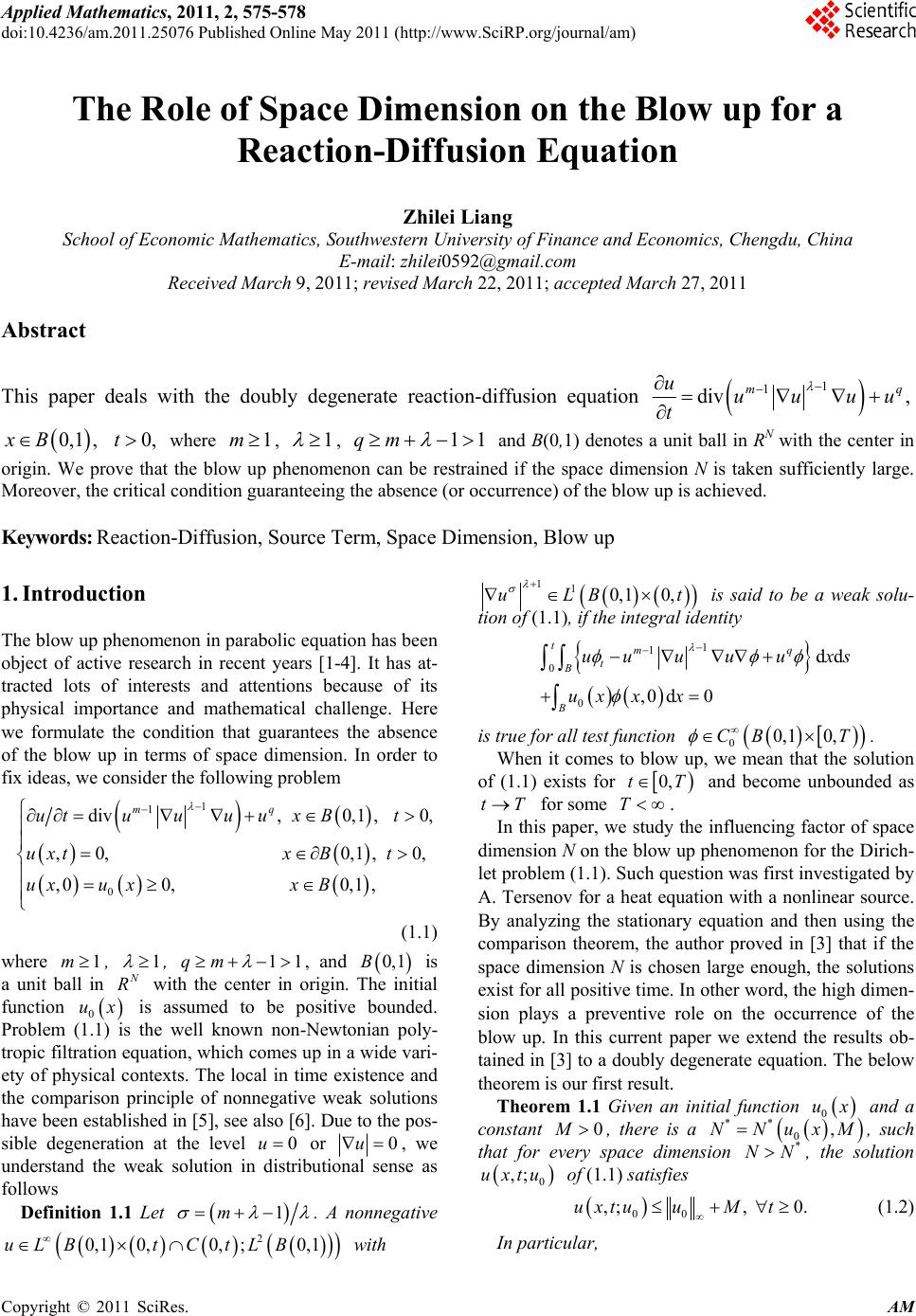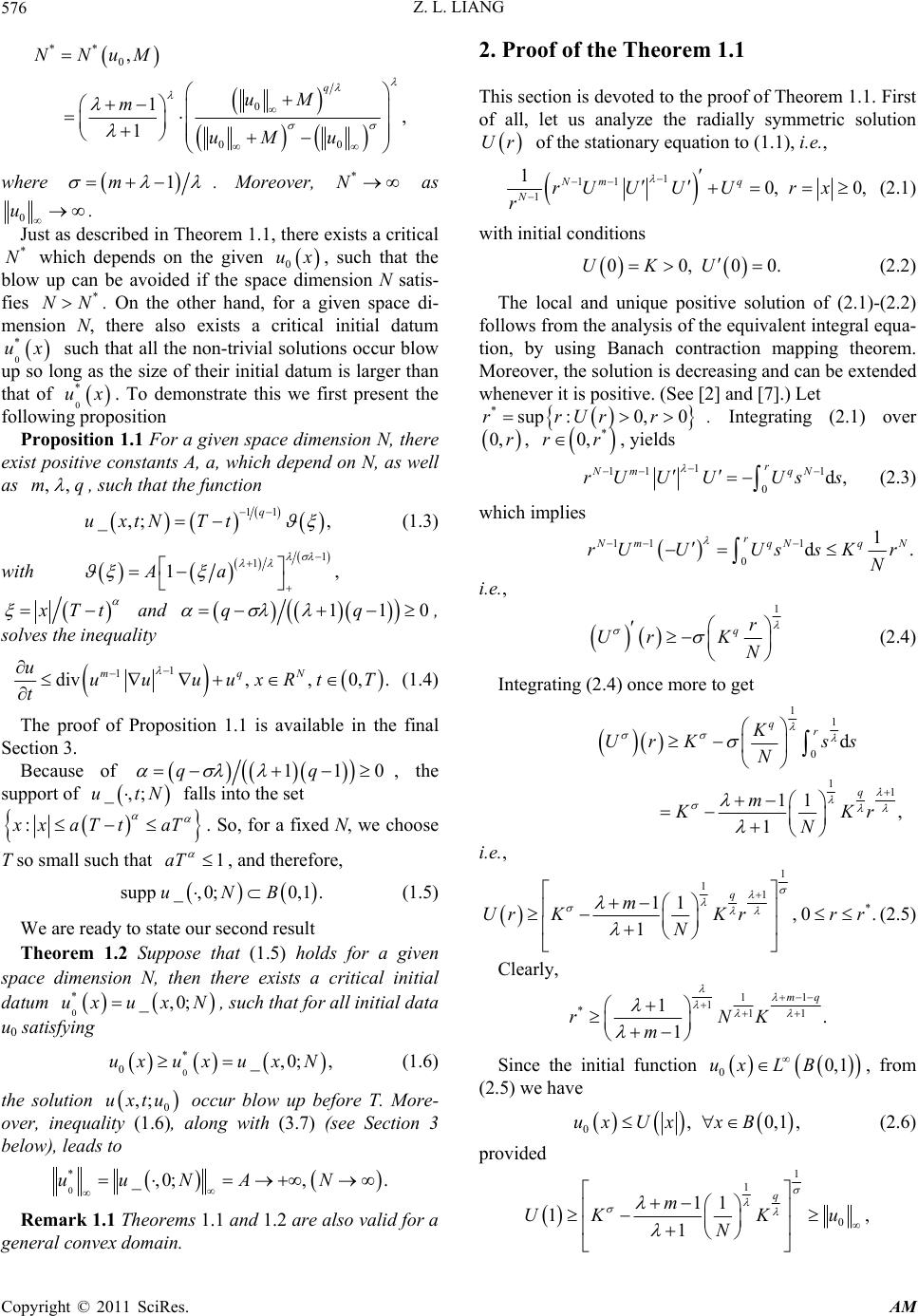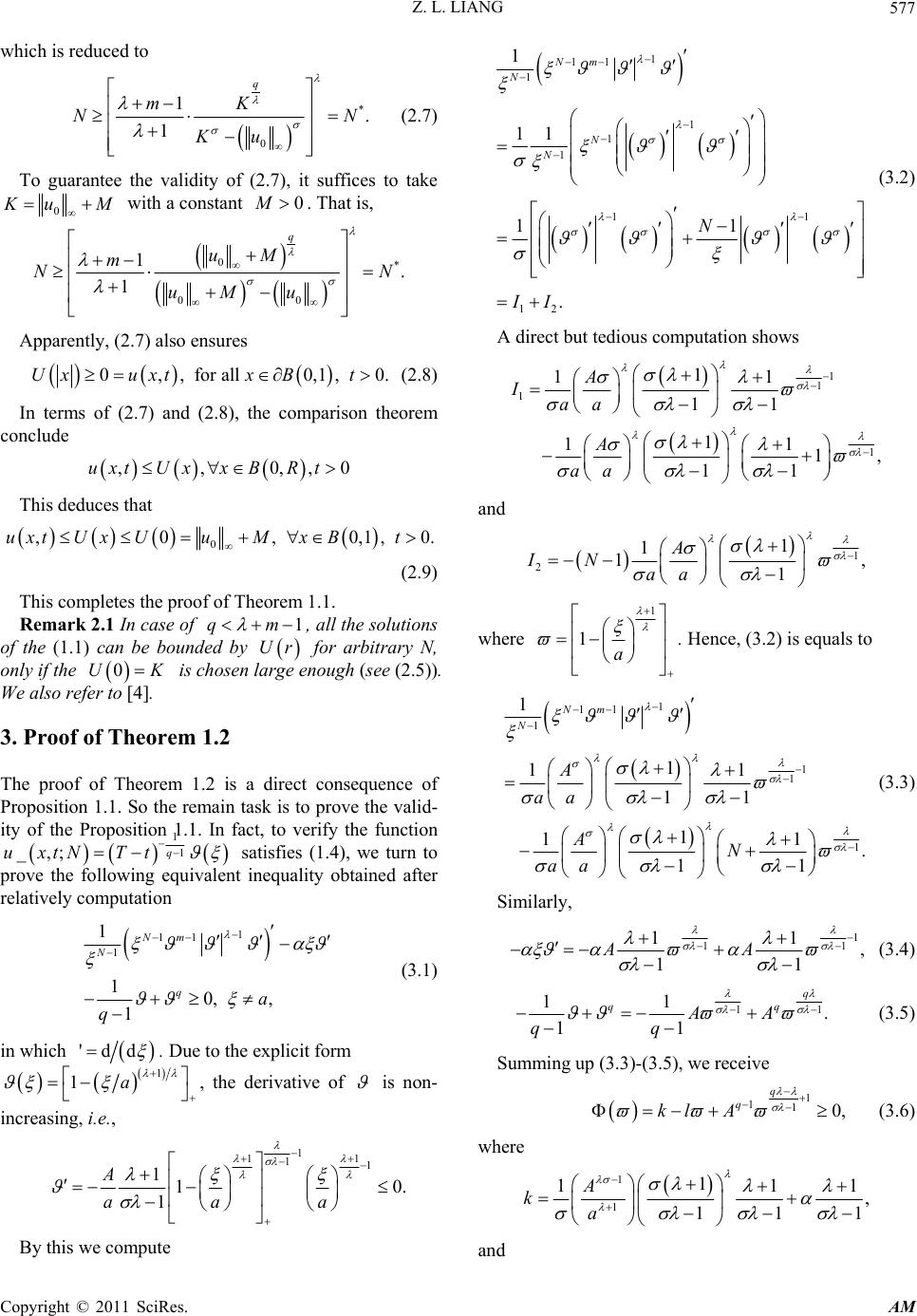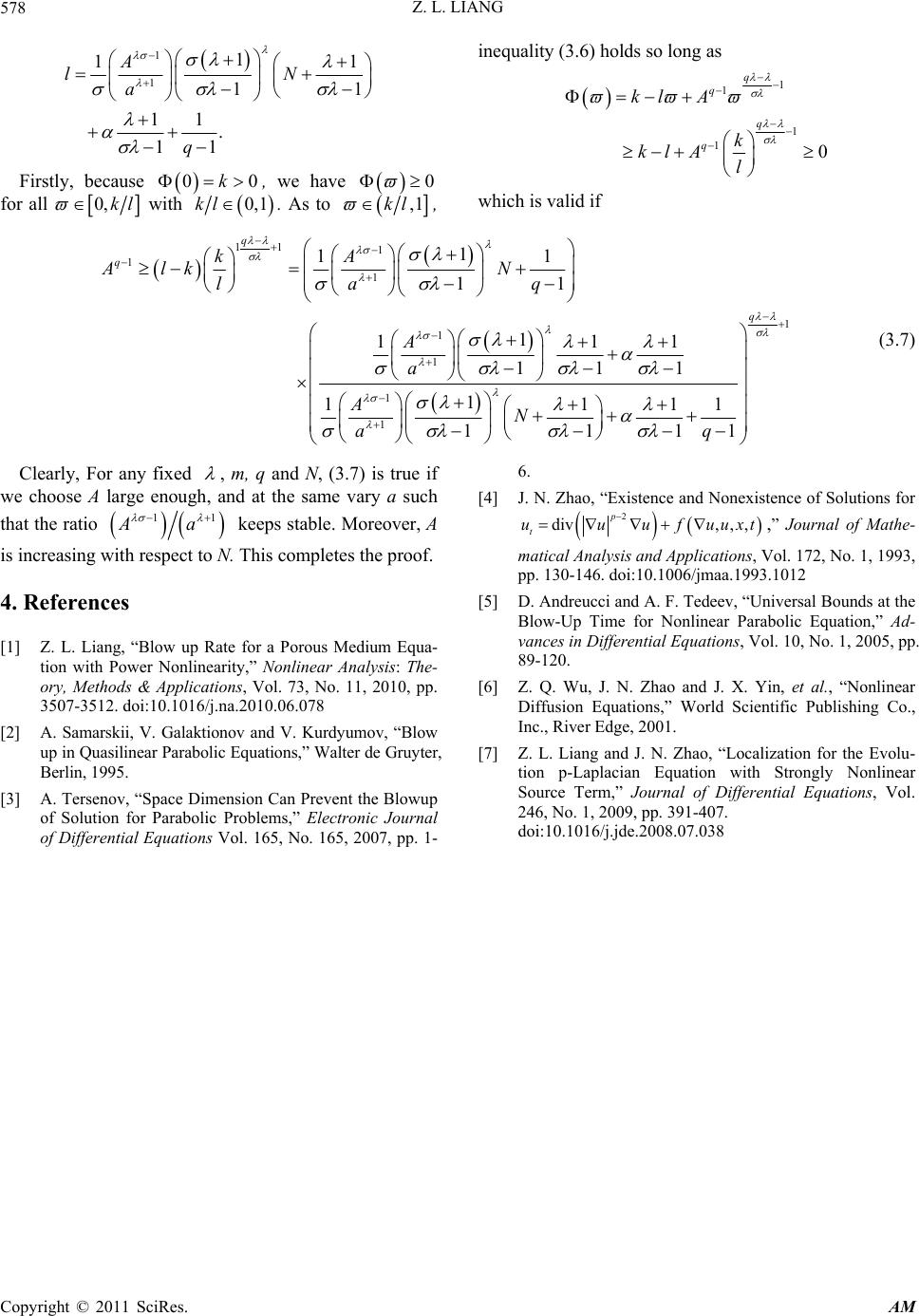 Applied Mathematics, 2011, 2, 575-578 doi:10.4236/am.2011.25076 Published Online May 2011 (http://www.SciRP.org/journal/am) Copyright © 2011 SciRes. AM The Role of Space Dimension on the Blow up for a Reaction-Diffusion Equation Zhilei Liang School of Economic Mathematics, Southwestern University of Finance and Economics, Chengdu, China E-mail: zhilei0592@gmail.com Received March 9, 2011; revised March 22, 2011; accepted March 27, 2011 Abstract This paper deals with the doubly degenerate reaction-diffusion equation 1 1 div , mq uuuuu t where , 0,1 ,xB0,t1m1 , 11qm and B(0,1) denotes a unit ball in RN with the center in origin. We prove that the blow up phenomenon can be restrained if the space dimension N is taken sufficiently large. Moreover, the critical condition guaranteeing the absence (or occurrence) of the blow up is achieved. Keywords: Reaction-Diffusion, Source Term, Space Dimension, Blow up 1. Introduction The blow up phenomenon in parabolic equation has been object of active research in recent years [1-4]. It has at- tracted lots of interests and attentions because of its physical importance and mathematical challenge. Here we formulate the condition that guarantees the absence of the blow up in terms of space dimension. In order to fix ideas, we consider the following problem 1 1 0 div,0,1 ,0, ,0, 0,1,0, ,00,0,1 , mq utuuu uxBt uxtx Bt uxu xxB (1.1) where , 1m1 , 11qm , and 0,1B is a unit ball in with the center in origin. The initial function 0 is assumed to be positive bounded. Problem (1.1) is the well known non-Newtonian poly- tropic filtration equation, which co mes up in a wide vari- ety of physical contexts. The local in time existence and the comparison principle of nonnegative weak solutions have been established in [5], see also [6]. Due to the pos- sible degeneration at the level or N R x u 0u0u, we understand the weak solution in distributional sense as follows Definition 1.1 Let 1m . A nonnegative 2 0,10,0, ;0,1uLBtCtLB with 110,1 0,uLB t is said to be a weak solu- tion of (1.1), if the integral identity 1 1 0 0 dd ,0 d0 tmq t B B uuuuu x ux xx s is true for all test function . 00,1 0,CB T When it comes to blow up, we mean that the solution of (1.1) exists for 0,tT and become unbounded as for some TtT . In this paper, we study the influencing factor of space dimension N on the blow up phenomenon for the Dirich- let problem (1.1). Such question was first investigated by A. Tersenov for a heat equation with a nonlinear source. By analyzing the stationary equation and then using the comparison theorem, the author proved in [3] that if the space dimension N is chosen large enough, the solutions exist for all positive time. In other word, the high dimen- sion plays a preventive role on the occurrence of the blow up. In this current paper we extend the results ob- tained in [3] to a doubly degenerate equation. The below theorem is our first result. Theorem 1.1 Given an initial function 0 ux ,xM and a constant , there is a , such that for every space dimension , the solution 0M** 0 NNu* NN 0 ,;uxtu of (1.1) satisfies 00 ,;, 0.uxtuuMt (1.2) In particular,  Z. L. LIANG 576 ** 0 0 00 , 1, 1 q NNuM uM m uM u where 1m . Moreover, as * N 0 u. Just as described in Theorem 1.1, there exists a critical which depends on the given , such that the blow up can be avoided if the space dimension N satis- fies . On the other hand, for a given space di- mension N, there also exists a critical initial datum 0 such that all the non-trivial solutions occur blow up so long as the size of their initial datum is larger than that of 0. To demonstrate this we first present the following proposition * N * u 0 ux * NN x * u x Proposition 1.1 For a given space dimension N, there exist positive constants A, a, which depend on N, as well as ,,mq , such that the function 11 ,; , q uxtNTt (1.3) with 1 1 1,Aa Tt and 11qq 0, solves the inequality 1 1 div,,0, . mqN uuuuuxRtT t (1.4) The proof of Proposition 1.1 is available in the final Section 3. Because of 11qq 0 , the support of ,;utN falls into the set : xaTt aT . So, for a fixed N, we choose T so small such that , and therefore, 1aT supp_,0;0,1 .uNB (1.5) We are ready to state our second result Theorem 1.2 Suppose that (1.5) holds for a given space dimension N, then there exists a critical initial datum 0 * ,0;uxux N, such that for all initial data u0 satisfying 0 * 0 ,0; ,uxuxu x N (1.6) the solution occur blow up before T. More- over, inequality (1.6), along with (3.7) (see Section 3 below), leads to 0 ,;uxtu 0 * ,0;, .uuNA N Remark 1.1 Theorems 1.1 and 1.2 are also valid for a general convex domain. 2. Proof of the Theorem 1.1 This section is devoted to the proof of Theorem 1.1. First of all, let us analyze the radially symmetric solution Ur of the stationary equation to (1.1), i.e., 1 11 1 10, 0, Nm q NrUUUUrx r (2.1) with initial conditions 00,0UKU 0. (2.2) The local and unique positive solution of (2.1)-(2.2) follows from the analysis of the equivalent integral equa- tion, by using Banach contraction mapping theorem. Moreover, the solution is decreasing and can be extended whenever it is positive. (See [2] and [7].) Let *sup :0,0rrUrr . Integrating (2.1) over 0,r, * 0,rr, yields 1 11 1 0d, r Nm qN rU UUUss (2.3) which implies 11 1 0 1 d. r mqNq rUUUssKr N N i.e., 1 qr Ur K N (2.4) Integrating (2.4) once more to get 11 0 11 d 11 , 1 qr q K UrK ss N m KK N r i.e., 1 11* 11 ,0 . 1 q m UrKKrr r N (2.5) Clearly, 11 1 *11 1. 1 mq rNK m Since the initial function , from (2.5) we have 00, 1ux LB 0,0ux UxxB,1, (2.6) provided 1 1 0 11 1, 1 q m UKK u N Copyright © 2011 SciRes. AM  Z. L. LIANG577 which is reduced to * 0 1. 1 q mK NN Ku (2.7) To guarantee the validity of (2.7), it suffices to take 0 u M with a constant . That is, 0M 0* 00 1. 1 q uM m NN uM u Apparently, (2.7) also ensures 0,,forall 0,1,0Uxuxtx Bt 0 . (2.8) In terms of (2.7) and (2.8), the comparison theorem conclude ,,0,,uxtUxxBR t This deduces that 0 ,0,0,1,uxtUxUuMx Bt 0. (2.9) This completes the proof of Theorem 1.1. Remark 2.1 In case of 1qm Ur, all the solutions of the (1.1) can be bounded by for arbitrary N, only if the is chosen large enoug h (see (2.5)). We also refer to [4]. 0UK 3. Proof of Theorem 1.2 The proof of Theorem 1.2 is a direct consequence of Proposition 1.1. So the remain task is to prove the valid- ity of the Proposition 1.1. In fact, to verify the function 1 1 _,; q uxtNTt satisfies (1.4), we turn to prove the following equivalent inequality obtained after relatively computation 1 11 1 1 10, , 1 Nm N qa q (3.1) in which 'dd . Due to the explicit form 1 1a , the derivative of is non- increasing, i.e., 1 11 11 110. 1 A aaa By this we compute 1 11 1 1 1 1 11 12 1 11 11 . Nm N N N N II (3.2) A direct but tedious computation shows 1 1 1 1 1 11 11 1 11 1, 11 A Iaa A aa and 1 2 1 1 1, 1 A INaa where 1 1a . Hence, (3.2) is equals to 1 11 1 1 1 1 1 1 11 11 1 11 . 11 Nm N A aa AN aa (3.3) Similarly, 1 11 11 , 11 AA (3.4) 1 11 . 11 q qq AA qq 1 (3.5) Summing up (3.3)-(3.5), we receive 1 110, q q kl A (3.6) where 1 1 1 11 , 11 A ka 1 1 and Copyright © 2011 SciRes. AM  Z. L. LIANG Copyright © 2011 SciRes. AM 578 1 1 1 1 11 11 . 11 A lN a q 1 0 Firstly, because , we have 0k 0 for all 0,kl with 0, 1kl. As to ,1kl , inequality (3.6) holds so long as 1 1 1 10 q q q q kl A k klAl which is valid if 11 1 1 1 1 1 1 1 1 11 11 1 111 111 1 111 1111 q q q kA AlkN lq a A a ANq a 1 1 (3.7) Clearly, For any fixed , m, q and N, (3.7) is true if we choose A large enough, and at the same vary a such that the ratio 1 Aa 1 keeps stable. Moreover, A is increasing with respect to N. This completes the proof. 4. References [1] Z. L. Liang, “Blow up Rate for a Porous Medium Equa- tion with Power Nonlinearity,” Nonlinear Analysis: The- ory, Methods & Applications, Vol. 73, No. 11, 2010, pp. 3507-3512. doi:10.1016/j.na.2010.06.078 [2] A. Samarskii, V. Galaktionov and V. Kurdyumov, “Blow up in Quasilinear Parabolic Equations,” Walter de Gruyter, Berlin, 1995. [3] A. Tersenov, “Space Dimension Can Prevent the Blowup of Solution for Parabolic Problems,” Electronic Journal of Differential Equations Vol. 165, No. 165, 2007, pp. 1- 6. [4] J. N. Zhao, “Existence and Nonexistence of Solutions for ,,,uuxt,” Journal of Mathe- matical Analysis and Applications, Vol. 172, No. 1, 1993, pp. 130-146. 2 div p t uuuf doi:10.1006/jmaa.1993.1012 [5] D. Andreucci and A. F. Tedeev, “Universal Bounds at the Blow-Up Time for Nonlinear Parabolic Equation,” Ad- vances in Differential Equations, Vol. 10, No. 1, 2005, pp. 89-120. [6] Z. Q. Wu, J. N. Zhao and J. X. Yin, et al., “Nonlinear Diffusion Equations,” World Scientific Publishing Co., Inc., River Edge, 2001. [7] Z. L. Liang and J. N. Zhao, “Localization for the Evolu- tion p-Laplacian Equation with Strongly Nonlinear Source Term,” Journal of Differential Equations, Vol. 246, No. 1, 2009, pp. 391-407. doi:10.1016/j.jde.2008.07.038
|